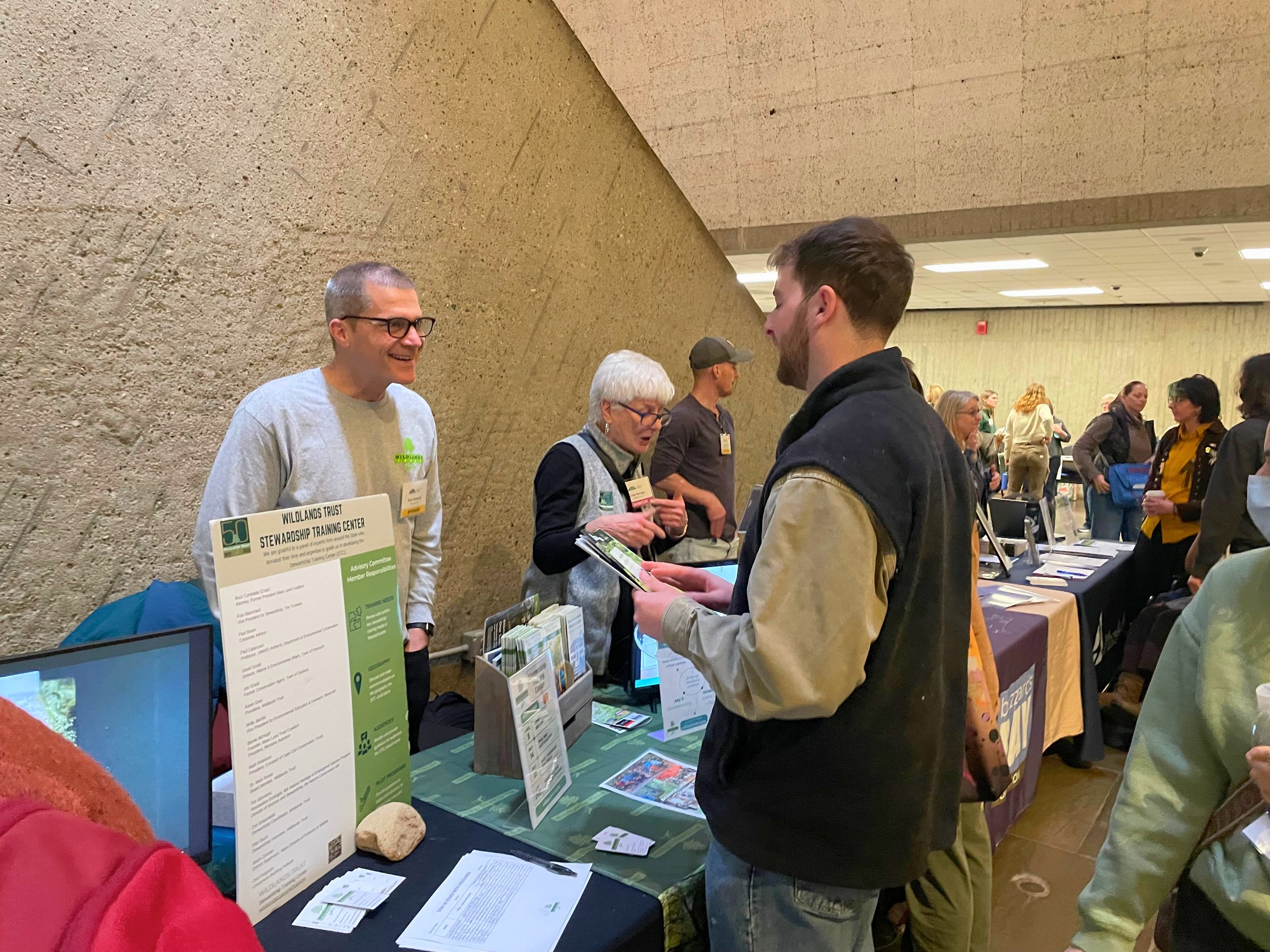STC House Managers Paul Gallerani and Judy Savage share information about the Stewardship Training Center with attendees of the 2025 Massachusetts Land Conservation Conference.
At Wildlands, we’re always looking for ways to improve and expand our work in Southeastern Massachusetts. Sometimes, that search leads us far beyond our region’s borders. Invariably, we come home with new insights, skills, and relationships to share with the communities we serve.
On March 21, a record 15 (!) Wildlands staff members and volunteers traveled to Amherst for the 2025 Massachusetts Land Conservation Conference, hosted by the Massachusetts Land Trust Coalition (MLTC). Wildlands Trust is a strong supporter of MLTC’s mission “to advance land conservation across Massachusetts by providing education, tools, networking and advocacy for land trusts and their partners.” In addition to sponsoring the annual conference, Wildlands shares Chief of Staff Rachel Bruce with the MLTC Board of Trustees.
“The Massachusetts Land Trust Coalition provides the platform for land conservation professionals to stay connected to one another and to present a unified voice,” Wildlands President Karen Grey said. Grey served on the MLTC board for 14 years. “Wildlands Trust is a stronger organization because of the resources we access through our active participation in MLTC.”
Wildlands President Karen Grey spoke about our Brockton Kids Lead the Way Initiative with Manomet Conservation Sciences during her presentation about our Community Stewardship Program.
Beyond our attendance numbers, Wildlands was well-represented at the conference, presenting workshops, organizing networking events, and tabling with information about the Stewardship Training Center. Four Wildlands-hosted workshops shared our successes and lessons learned with the state land conservation community. Karen Grey presented with Jen Plowden of the Land Trust Alliance about “A Blueprint for Better Boards: Three Strategies for Board Recruitment.” Land use attorney and Dennis Murphy presented on Wildlands' complex project to save Picone Farm in Middleborough. Rachel Bruce and Programming Coordinator Amy Burt presented “Beyond DEI Statements: A Case Study for Delivering a Land Trust Mission in a Gateway City,” recounting our ongoing environmental justice work in Brockton. To end the day, Karen Grey presented once again, this time with Barnstable Land Trust’s Janet Milkman about our Community Stewardship Program.
The MLTC conference offers land conservation professionals a rare opportunity to bond over their shared missions and values. Communications Coordinator Thomas Patti serves on the Organizing Committee of the Early Conservation Career Network (ECCN), an interest group of the MLTC that “provides networking and training opportunities for those in their first 10 years of a career in land conservation.” ECCN gathers the night before the conference every year to build camaraderie and community. This year, the event saw over 30 early-career conservationists, including eight from Wildlands, learn about spotted salamanders at the Hitchcock Center for the Environment before heading to Tree House Brewing Company for pizza and drinks.
Stewardship Programs Manager Zoë Smiarowski also led a stewardship networking lunch during the conference, giving land stewards across the state a chance to come together and “talk shop.”
Below, hear from Wildlands staff and volunteers about their experiences at this year’s Massachusetts Land Conservation Conference.
Rachel Bruce, Chief of Staff & MLTC Trustee
“The conference is a great opportunity for Wildlands both to showcase our work to our colleagues, as demonstrated at our multiple presentations and our outreach table, and to learn from the incredible work taking place at nonprofits and state agencies across the state. Networking with land professionals from many walks opens up doors for creative problem solving, big-picture thinking, and meaningful collaboration that advances our collective mission to protect and steward Massachusetts' natural landscapes.”
Amy Burt, Programming Coordinator
"The ECCN meeting was a timely reminder of the importance of new generations' commitment to the conservation field. I am inspired to look towards the future with such enthusiastic individuals."
Rob Kluin, Donor Relations Manager
“Overall, the Massachusetts Land Conservation Conference was very beneficial for me. Beyond the knowledge and great insights that I gained from a variety of informative workshops, the conference offered many opportunities for making conversations and meaningful connections. I was impressed by the mission-driven organizations and passionate people at this conference and came away feeling inspired and even more grateful for the work of Wildlands Trust.”
U.S. Representative Jim McGovern delivered the keynote address at the 2025 Massachusetts Land Conservation Conference.
Zoë Smiarowski, Stewardship Programs Manager
“At my first MLTC conference in 2023, I spent a lot of time at the Stewardship Training Center table, talking with folks. This time around, I had the opportunity to attend more sessions. I really enjoyed not only the speakers but also listening to questions and comments for the speakers from audience members. It's inspiring to see the ways our land trust community shows up for each other and engages in reciprocal learning.”
Rebecca Cushing, Land Steward
“The ECCN 'Big Night' talk and social gathering was definitely a highlight for me. I loved connecting with a diverse group of people brought together by their passion for conservation and hear about what they're doing in the early stages of their careers in the field. I also really enjoyed the presentation on managing invasive plants at the conference. The presenters shared their unique experiences in great detail and offered strategies that could be applied across different organizations with different resources and goals.”
Sam Butcher, D.W. Field Park Initiative Project Facilitator
“As a member of a challenged land trust board, I found Karen Grey and Jen Plowden’s talk on how to build a successful board extremely insightful and helpful. The interactive role-play format highlighted board challenges and brought audience members into the presentation, further broadening the perspective and enhancing the value of the presentation.”
Paul Gallerani, Assistant STC House Manager
“It was so nice to be surrounded by hundreds of people that care about the environment. Such a new thing for me. It charged my nature battery!”

























